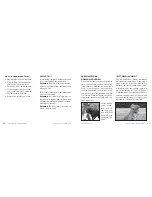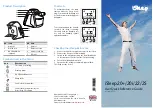
8
Sport Junior Dog Training Guide
customer service 1-800-456-4343
www.tritronics.com
Sport Junior Dog Training Guide
9
and later a “long line” or rope, together
with his previous training on the com-
mand, is the best way to guarantee good
learning.
When he shows you that he’s responding
well to the nick by performing the com-
mand, and does not become confused,
then you can phase out the leash or rope.
When phasing it out, let your dog drag
it during training for a session and then
take it off completely. Put it back on for
a little while longer if your dog seems to
be having too much trouble understand-
ing what you want.
During a dog’s early e-collar training
with a leash or rope, it’s best to fasten it
to a separate collar, not the e-collar itself.
Later you can have the leash or rope on
the e-collar D ring if you prefer.
obedience located at the end of the Sport
Junior Training DVD. There are also
many fine books, videos, and training
classes offering obedience programs.
WHAT YOU NEED
BEFORE YOU START
1. Your Sport Junior e-collar.
2. A flat buckled collar on your dog
in addition to the Sport Junior.
3. A leash and a 20-foot rope or “long
line.” For a bird dog you may want
a longer “check cord.”
4. Toys your dog likes playing with.
5. Training areas:
You need a quiet distraction-free
area for first sessions on a command.
You need areas with gradually
increasing distractions for later work.
USING LEASHES AND ROPES
Why do we start a dog’s e-collar Les-
sons on a leash or a rope? After all, isn’t
the point of a remote trainer to get away
from that restriction?
Yes it is. However, the introduction to
e-collar training is about teaching your
dog to understand the e-collar nick it-
self. Your dog will not automatically
understand that obeying a command is
the “right answer” when he feels the e-
collar. This is true no matter how well he
knows the command.
To help him learn what to do about the e-
collar nick and keep him from becoming
confused, it is important that you have
a way to guide him in early sessions on
each command. Having him on a leash,







































